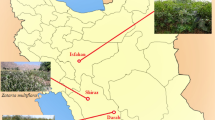Abstract
Naphthalin derived from the essential oil of Magnolia liliflora was tested for antibacterial activity against oral bacteria. Naphthalin showed strong growth inhibitory activity against Actinomyces viscosus and Streptococcus salivarius, and exhibited moderate or weak growth inhibitory activity against Porphyromonas spp. and Streptococcus spp. at 2.0 mg/disc, whereas Lactobacillus rhamnosus showed no growth inhibition. Therefore, M. liliflora could be useful as a natural preventive agent.
Similar content being viewed by others
References
Axelsson P, Albandar JM, and Rams TE (2002) Prevention and control of periodontal diseases in developing and industrialized nations. Periodontol 2000 29, 235–246.
Azuma H, Toyota M, Asakawa Y, and Kawano S (1996) Naphthalene—a constituent of Magnolia flowers. Phytochemistry 42, 999–1004.
Baehni PC and Takeuchi Y (2003) Anti-plaue agents in the prevention of biofilm-associated oral diseases. Oral Dis 9, 23–29.
Bajpai VK, Rahman A, Dung NT, Kuh MK, and Kang SC (2008) In vitro inhibition of food spoilage and foodborne pathogenic bacteria by essential oil and leaf extracts of Magnolia liliflora Desr. J Food Sci 73, M314–320.
Benzic N, Skocibusic M, Dinkic V, and Radonic A (2003) Composition and antimicrobial activity of Achillea clavennae L. essential oil. Phytother Res 17, 1037–1040.
Burne RA and Marquis (2000) Alkali production by oral bacteria and protection against dental caries. FEMS Microbiol Lett 193, 1–6.
Gomi K, Yashima A, Nagano T, Kanazashi M, Maeda N, and Arai T (2007) Effects of full-mouth scaling and root planning in conjunction with systemically administered azithromycin. J Periodontol 78, 422–429.
Jeon JH, Lee CH, Kim MK, and Lee HS (2009) Antibacterial effects of juglone and its derivatives against oral pathogens. J Korean Soc Appl Biol Chem 52, 720–725.
Kim HW, Lee CH, Kim MG, and Lee HS (2009) Antibacterial activities of phenethyl isothiocyanate and its derivatives against human oral pathogens. J Korean Soc Appl Biol Chem 53, 555–559.
Kim MG and Lee HS (2009) Growth-inhibiting activities of phenethyl isothiocyanate and its derivatives against intestinal bacteria. J Food Sci 74, M467–471.
Kim MG, Choi GJ, and Lee HS (2003) Fungicidal property of Curcuma longa L. rhizome-derived curcumin against phytopathogenic fungi in a greenhouse. J Agric Food Chem 51, 1578–1581.
Kim SS, Oh HJ, Baik JS, Oh TH, Yun PY, Kim CS et al. (2008) Chemical composition and biological activities of Elsholtzia splendens essential oil. J Appl Biol Chem 51, 69–72.
Lee HS and Ahn YJ (1998) Growth-inhibiting effects of Cinnamomum cassia bark-derived materials on human intestinal bacteria. J Agric Food Chem 46, 8–12.
Park BS, Lee HK, Lee SE, Piao XL, Takeoka GR, Wong RY et al. (2006) Antibacterial activity of Tabebuia impetiginosa Martius ex DC (Taheebo) against Helicobacter pylori. J Ethnopharmacol 105, 255–262.
Petersen PE and Lennon MA (2004) Effective use of fluorides for the prevention of dental caries in the 21st century: the WHO approach. Community Dent Oral Epidemiol 32, 319–321.
Sato M, Fujiware S, Tsuchiya H, Fujii T, Linuma M, Tosa H et al. (1996) Flavones with antibacterial activity against cariogenic bacteria. J Ethnopharmacol 54, 171–176.
Science Lab Inc. (2010) Material safety data sheet. Science Lab Inc., Houston, TX.
Takarada K, Kimizuka R, Takahashi N, Honma K, Okuda K, and Kato T (2004) A comparison of the antibacterial efficacies of essential oils against oral pathogens. Oral Microbiol Immnol 19, 61–64.
Wang X, Wang Y, Geng Y, Li F, and Zheng C (2004) Isolation and purification of honoliol and magnolol from cortex Magnoliae officinalis by high-speed counter-current chromatography. J chromatogr 1036, 171–175.
Yim NH, Ha DT, Trung TN, Kim JP, Lee SM, Na MK et al. (2010) The antimicrobial activity of compounds from the leaf and stem of Vitis amurensis against two oral pathogens. Bioorg Med Chem Lett 20, 1165–1168.
Author information
Authors and Affiliations
Corresponding author
Rights and permissions
About this article
Cite this article
Song, HY., Lee, HS. Antibacterial activity of naphthalin and its derivatives against oral bacteria. J Korean Soc Appl Biol Chem 55, 183–187 (2012). https://doi.org/10.1007/s13765-012-1162-1
Received:
Accepted:
Published:
Issue Date:
DOI: https://doi.org/10.1007/s13765-012-1162-1




